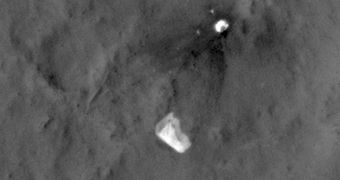Curiosity's been on Mars for a few months now. In that time, she made plenty of interesting and important discoveries and shot plenty of photos. But Curiosity was breaking new ground, so to speak, even before it landed on Mars.
In fact, even its landing was a first. Previously, all Mars rovers were small enough that they basically crashed into Mars, protected by huge airbags.
But Curiosity, which is the size of a large car, couldn't just be slammed into the ground and hope for the best.
It used a very complex landing mechanism, in the upper atmosphere it used a heat shield to both deflect the heat from the friction and most importantly, to slow down. During this stage, the rover went from 5.8 km/s (3.6 mi/s) to about 578 m/s (1,900 ft/s).
The supersonic parachute took over from here, as the heat shield separated, and continued to slow down the rover to about 100 m/s (220 mph). It's at this point that the descent stage took over and the parachute was disconnected.
This descent stage was powered by four rocket thrusters that were used to slow down and maneuver the rover into position. When it was close enough, the rover was lowered down via the sky crane. As soon as the rover was safely on the ground, the descent stage flew away and crashed nearby.
All of this created a lot of debris. In fact, several remains of the different stages have been observed by Mars orbiters since.
The latest is the landing parachute which is still flapping in the Martian wind half a year after it landed. NASA published an animation of the parachute put together from seven images captured by HiRISE over several months.
The parachute quite obviously moves between the frames, so it's being pushed around by wind, though there doesn't seem to be that much of it.

 14 DAY TRIAL //
14 DAY TRIAL //